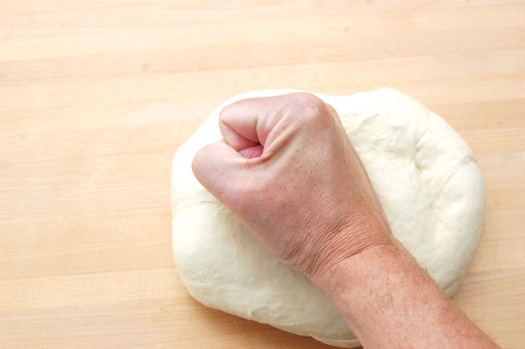The Difference Between Punching and De-Gassing

Reader Sally had a great question: what’s the difference between “punching down” dough and “gently de-gassing” it as so many artisan bread recipes instruct? Functionally speaking, Sally, there’s not that much difference, both are about releasing built up CO2 and stretching the dough to further distribute the yeast (being buds, yeast don’t move on their own so we have to manually move them if we want to spread them around a bread dough).
That said, the texture of your bread will be different depending on whether you punch your dough or handle it with, er, kid gloves. Punching dough not only deflates large bubbles it breaks them up into lots of smaller ones. After a well-punched dough is baked it tends to have a very tight crumb, which is desirable for sandwich breads, pain de mie and such. Big holes just let sandwich fillings fall through, which is why it’s important to beat sandwich breads mercilessly.
“De-gassing” is what you do for artisan-style breads since the big holes are part of the aesthetic. The idea is to apply only gentle pressure so that the CO2 escapes but the gaps inside the dough are more or less preserved. That’s a good thing since they’ll fill up again with CO2 in the proofing step and bake up to a nice open crumb (i.e. full of holes).
Thank you! Not having access to cooking shows on TV, I’ve never seen a demonstration or explanation of “de-gassing” before. Very, very helpful.
I’m glad, Sally. Yes, de-gassing is usually just stretching or simple folding. Hope it’s helpful in your bread making!
Cheers,
– Joe
This Thanksgiving I want to give thanks to you Joe. Your simple and straightforward explanations about — a lot of things — help me to understand what I never knew. I do know that writing simply and understandably is not easy work. It takes a masterful command of the subject and a special gift with words. You have both. And by giving away the knowledge that you know so well, you model what Thanksgiving is meant to be. Now for the stuffing!!!
You made my day, Jim!
Sorry it’s taken a while to get back to you. I was gone then I couldn’t access my own site for several days. But thank you very much indeed. This blog not only compels me to keep exploring (I get some great and difficult questions) it helps me keep my writing sharp. It’s not always easy to motivate myself after a holiday break, but comments like yours help me remember why I do this!
Cheers and thanks again. Hope you had a great Thanksgiving!
– Joe
What Jim said ^. I have learned so much from your blog…and I always give you credit when people compliment my baking. Thank you, Joe Pastry!
Thank you, Bill!
I love what I do!
– Joe
Me too!!!
Thanks, Rainey!
– Joe
I just can’t stop reading your blog! It’s full of knowledge and yummy tips. Thanks!
Thanks, Liz! Come back often! 😉
– Joe
As a (more or less) pro bread baker I agree with what you say, Joe, but would like to add a couple of details.
There are two points in the process where we de-gas/punch the dough. The first is during the first rise or bulk fermentation. The second is when we shape the dough just before it proves. Your explanation refers to the second time perfectly – it is, after all the last chance to get the dough texture right before baking.
I look at the de-gas/punch down/fold during the first fermentation a little differently. Although most domestic recipe books say to punch down the dough during first fermentation I prefer a more gentle folding. Even though I am still de-gassing and moving the yeast around, I am thinking more about increasing gluten strength through stretching the dough out and then folding it back over itself. This is especially important if you have hand kneaded the dough (which I don’t, thankfully).
So, as I see it, first time you “punch” the dough it doesn’t have as much effect on final texture as the second time when you are doing the final shaping.
Thank you for the good work on this site, Joe. It’s my go-to place for matters baking.
Well said, Donald, good point. You’re completely right that there are usually two punch-down points with bread making.Thanks for jumping on that!
Cheers and many thanks for the very kind compliment!
Cheers,
– Joe
Hello Joe,
Please I will like to ask you what composite flours are.
Presently the Nigerian Govt has requested that all flour millers should include cassava into wheat flour so as to support the agricultural industry and reduce buy of wheat from out side the country.
This new hybrid flour uses. Wheat flour of 90% and High Quality Cassava Flour of 10%.
Please can you expansiate more on composite flours and if it’s ok to use them for cake baking, especially American high ratio cakes.
Thank you.
Wale
Lagos Nigeria
Hi Wale!
Interesting question. I’ll answer this on the blog today.
Cheers,
– Joe